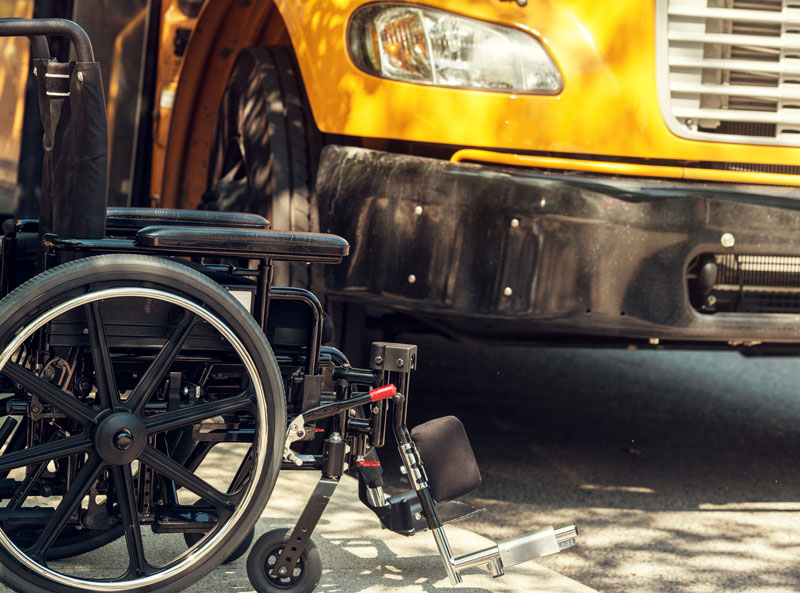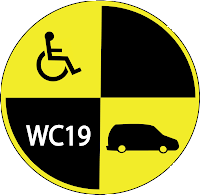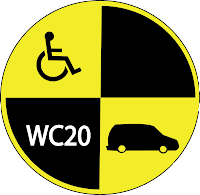Summer has come and gone, and school has started. It's a time of getting our kids settled into a new routine, including getting to and from school in a safe manner. For some, this means navigating their way through not only their child's transportation, but his/her wheelchair as well. You would think this should be an easy task to coordinate, but unfortunately it appears to be uncharted territory. I wish I could provide step-by-step instructions on the process, but sadly this does not appear to exist in most areas.

So now what? Let's look at various questions and the possible course of action that you can consider as you work through the process.
If my child uses a wheelchair, do they have to be transported in the wheelchair?
No, just because someone uses a wheelchair for their mobility, does not mean they have to be seated in the wheelchair while riding the bus. If they can be safely transferred and ride in the bus seat, then the wheelchair can be secured properly during transportation. If the child cannot be transferred, then you need to be certain that they are in an appropriately tested wheelchair and seating system for their safety.
Are all wheelchairs tested and certified to be transported on a bus?
No, all wheelchairs are not tested for safe bus transportation while an end-user is actually sitting in the wheelchair as their seat. You can review this webpage to find two separate lists: one for wheelchairs and one for seating systems that have been tested.
Interestingly enough, not all schools require a wheelchair to have an approved transit option. What exactly does that mean? First, you need to be aware that some people use the term "transit option" interchangeably. There are systems that are actually the ones on the bus/vehicle itself (tie-down straps) and there are transit options that are physically on the wheelchair system. In this blog, we are specifically talking about the transit option.
The industry has two standards for transit options: one for the actual wheelchair and another for the seating systems. These standards are called WC19 AND WC20. WC19 is a revised and updated version of Section 19 of the American National Standards Institute/Rehabilitation Engineering and Assistive Technology Society of North America (ANSI/RESNA) Wheelchair Standards/Volume 1: Wheelchair Used as Seats in Motor Vehicles (updated December 2017). Wheelchairs that comply with WC19 are labeled with this symbol:

WC20, also a part of the ANSI/RESNA Wheelchair Standards, but Volume 4: Wheelchairs and Transportation. Seating systems that comply with WC20 are labeled with this symbol:

Again, the difference between these two standards is that WC19 is for the wheelchair and WC20 is for the seating system.
Simply put, a wheelchair and/or seating system will be placed through specific testing, providing a greater level of safety for the child. Be aware the testing was for the transit option on the specified systems. More information on these certifications and specific requirements can be found here.
It appears that the transit brackets are options on the wheelchair with an additional cost. Will my insurance or the school cover the extra cost?
As nonsensical as this may seem, most insurances do not cover the transit option; this includes most Medicaid agencies (but not all). However, this does not mean that there are no other options. You will just need to be your own advocate and dig deep during your research process.
You will want to check with the school. Do not simply ask if they will fund the transit option, but also if there are any financial assistance programs or grants that the school could provide. I do know of schools that require the transit brackets to be on the wheelchair and if so, I would argue that they should provide the funding. Even if they did not require it, it would be in their best interest due to liability issues. In addition, if you review some of the laws/regulations listed below, it should assist you in winning the battle.
If the child is covered under the Medicaid program and they deny the option, then be sure to look into their waiver programs (some states may call these by a different name). These are separate/additional programs that provide additional funding. I have also found that they Medicaid plans, and other insurances sometimes have grants that can assist with the payment.
I am also a proponent of community programs, meaning that there are many communities that will come together to help one another. This may come in the form of specific grants, fundraisers, and other programs. The first step is to be proactive and simply ask. you could even work with a case manager to assist with this or any other funding possibilities. The more they learn, the more they can help.
Lastly, the law is always a great argument and advocate for an item such as the transit option to be funded. This is not the most entertaining information to read, but use any of the following if needed:
The Rehabilitation Act of 1973, Public Law (PL) 93-112, has several sections that discuss transportation and the responsibilities of those receiving federal funds (i.e. public schools). This law states, "No otherwise qualified disabled individual in the United States shall, solely by reason of his handicap, be excluded from participating in, be denied the benefits of, or be subjected to discrimination under any program or activity receiving federal financial assistance." In general terms, Section 504 "...requires that all students with disabilities (regardless of age) are eligible for a free appropriate public education [FAPE]."
Congress passed Public Law (PL) 94-142 in 1975. This law guarantees a free appropriate public education (FAPE) to each child with a disability between the ages of 3 and 21 years. This law clearly states "state and local educational agencies can and will provide effective special education and related services to meet the needs of handicapped children..." The law then goes on to state that the term "related services" means transportation and such developmental, corrective, and other supportive services. The term "free appropriate public education" means special education and related services which have been provided at public expense, under public supervision and direction, and without charge.
In 2004, the re-authorization of the Education for All Handicapped Children Act of 1975 changed the name to Individuals with Disabilities Education Improvement Act (IDEIA/IDEA). Section 1401 (26) of this Act documents the same definition for "related services." IDEA requires the public agency "...to provide non-academic and extracurricular services and activities in such manner necessary as to afford children with disabilities an equal opportunity for participation in those services" (Section 300.107). One of the ways to access those non-academic services is transportation. This law continues the emphasis on the transportation of children with disabilities in the same ways children without disabilities are transported.
About the Author

Claudia Amortegui received her Masters degree in Business Administration from the University of South Carolina. She joined Palmetto Government Benefits Administrators (DMERC Region C) as an ombudsman. She worked with Palmetto for three years assisting Durable Medical Equipment, Prosthetics, Orthotics, and Supplies (DMEPOS) providers in learning medical policies and proper claims submission. She then became a sales representative for Quickie Designs, a division of Sunrise Medical, with responsibility for the sale of wheelchairs and seating systems in the Northern Florida and Southern Georgia territory.
Claudia then moved to Chicago to become the Director of Reimbursement for American Pharmaceutical Services, a national long-term care supplier. In early 1998, she returned to Sunrise Medical to begin a new venture for the company as Director of Consulting Services. In this role, she oversaw the management of a national consulting group specializing in Medicare reimbursement. In November 2002, she purchased Sunrise Consulting and formed The Orion Group.
Claudia’s experience comes from having worked on all sides of the industry, including funding source (Medicare), supplier, manufacturer, and consultant. This rare combination of industry experience enables Claudia and her team at The Orion Group to assist people in understanding the reimbursement process and to teach them how they can not only be successful, but also outperform others in the industry.
Most of the stories here on Live Quickie were submitted by readers. Do you have a story to tell? We'd love to hear it. Submit your story here.